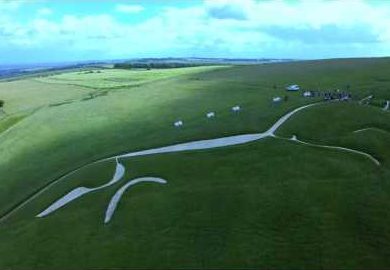A huge war horse has appeared in a Suffolk field to mark the centenary of the end of the First World War.
It is one of a series of ploughed artworks produced by geography teacher Carlo Roberts and his friend Stefan Fulcher on land owned by farmer Tom Baldwin.
“We’ve created these things before but never a horse,” said Carlo. “We wanted to commemorate the centenary of the end of the war, as well as remember the contribution horses made to the war effort.”
The 120m x 250m land art took around two days to create, with Carlo making preliminary sketches before the finalised image was marked out by hand on the field.
The horse was then ploughed in using discs by tractor driver Stefan, with the pair able to check the progress of their work by using a drone.
“Stefan is as much responsible for this as me, I haven’t got a clue with a tractor and he’s clever at working out how to make the lines make sense,” said Carlo. “Obviously it also couldn’t have taken place without the permission of the landowner.”
Carlo’s first venture into ploughed artworks was during 2012 when he wanted to create something to mark the London Olympics, so he approached Tom — who he’d bought a house from — with the idea.
“As well as 2012, one of the most notable [art works] we did was big B17 bomber shadow three years ago,” Carlo said. “In 2016 we also did an electric car with a wire coming out of the back attached to a wind turbine on his land.”
Carlo said the horse had in fact been one of the easier works they had produced.
“The plane was probably the hardest as it was filled in and on an oblique angle,” he said.
Continues below…

EU threat for white horse
Plans to carve a new white horse on a Kent hillside may have to be put on hold due to

Uffington White Horse gets a good groom

Subscribe to Horse & Hound magazine today – and enjoy unlimited website access all year round
He added that part of what had inspired them to create the horse was some of the ancient chalk examples found around Britain.
“I think horses are very beautiful and as well as considering the contribution they made to the war, we were also are of the tradition of carving huge horses into the landscape, and that was something that made it appealing,” he said.
For all the latest news analysis, competition reports, interviews, features and much more, don’t miss Horse & Hound magazine, on sale every Thursday.





